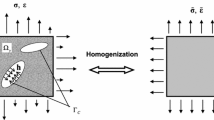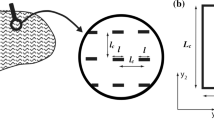Abstract
In this paper, a stochastic damage model is proposed for the rupture prediction of a brittle, multi-phase material. The model, based on the macrocrack-microcrack interaction, characterizes damage by microcracking and fracture by macrocracking. The model incorporates uncertainties in locations, orientations and numbers of microcracks. Owing to the high concentration of microcracks within the frontal damage zone near the macro-tip, a higher order analysis based on traction boundary integral equations is formulated for an arbitrary array of cracks. The change of the stress intensity at the macrocrack tip by the configuration of microcracks is investigated through a parametric study. The presence of large fluctuation in the stress intensity at the macro-tip justifies the use of the statistical approach, which will be presented in a companion paper.
Similar content being viewed by others
References
D.J. Neville, Engineering Fracture Mechanics 27 (1987) 143–155.
Y. Fu and A.G. Evans, Acta Metallurgica 33 (1985) 1515–1523.
E.A. Whitehurst, Monograph No. 2, American Concrete Institute, Detroit, Michigan (1966).
R. L'Hermite, RILEM Bulletin 18 (1954) 27–38.
R. Jones, British Journal of Applied Physics, London 3 (1952) 229–232.
F.O. Slate and S. Olsefski, Journal of the American Concrete Institute, Proceedings 60 (1963) 575–588.
R.G. Hoagland, G.T. Hahn and A.R. Rosenfield, Rock Mechanics 5 (1973) 77–106.
A. Hillerborg, M. Modeer and P.E. Petersson, Cement and Concrete Research 6 (1976) 773–782.
R. Ballarini, S.P. Shah and L.M. Keer, Engineering Fracture Mechanics 20 (1984) 433–445.
M. Ortiz, International Journal of Solids and Structures 24 (1988) 231–250.
R. Ballarini, Engineering Fracture Mechanics 35 (1990) 55–66.
B. Budiansky and R.J. O'Connell, International Journal of Solids and Structures 12 (1976) 81–97.
H. Horii and S. Nemat-Nasser, Journal of the Mechanics and Physics of Solids 31 (1983) 155–171.
N. Laws and J.R. Brockenbrough, International Journal of Solids and Structures 23 (1987) 1247–1268.
D. Sumarac and D. Krajcinovic, Mechanics of Materials 6 (1987) 39–52.
D. Krajcinovic and D. Fanella, Engineering Fracture Mechanics 25 (1986) 585–596.
J.W. Hutchinson, Acta Metallurgica 35 (1987) 1605–1619.
M. Ortiz and A.E. Giannakopoulos, Journal of Applied Mechanics 56 (1989) 279–283.
H. Horii and K. Sahasakmontri, Micromechanics and Inhomogeneity, G.J. Weng (ed.) Springer-Verlag, New York (1990) 137–159.
L.R.F. Rose, International Journal of Fracture Mechanics 31 (1986) 233–242.
R. Ballarini and M. Denda, International Journal of Fracture Mechanics 37 (1988) 61–71.
H. Horii and S. Nemat-Nasser, International Journal of Solids and Structures 21 (1985) 731–745.
M. Kachanov, International Journal of Fracture Mechanics 30 (1986) R65-R72.
M. Kachanov and E. Montagut, Engineering Fracture Mechanics 25 (1986) 625–636.
S.X. Gong and H. Horii, Journal of the Mechanics and Physics of Solids 37 (1989) 27–46.
M. Ruhle et al., Acta Metallurgica 35 (1987) 2701–2710.
D.J. Neville, International Journal of Fracture Mechanics 44 (1990) 79–96.
T.F. Wong, Mechanics of Materials 4 (1985) 261–276.
J.C.F. Telles, The Boundary Element Method Applied to Inelastic Problems, Lecture Notes in Engineering, 1, Springer-Verlag (1983).
Y. Murakami and S. Nemat-Nasser, Engineering Fracture Mechanics 17 (1983) 193–210.
N.I. Ioakimidis, Acta Mechanica 45 (1982) 31–47.
P.A. Martin, F.J. Rizzo and I.R. Gonsalves, Mechanics Research Communications 16 (1989) 65–71.
G. Krishnasamy et al., in: Proceedings 1st Joint Japan/US Symposium on Boundary Element Method, M. Tanaka and T.A. Cruse (eds.) Tokyo, Japan (1988) 227–237.
G.R. Irwin, in Handbook der Physik 79, Springer, Berlin, West Germany (1958), 551–590.
J.W. Nicholson and S.R. Mettu, Engineering Fracture Mechanics 31 (1988) 759–767.
M. Kachanov, International Journal of Solids and Structures 23 (1987) 23–43.
M. Hori and S. Nemat-Nasser, Journal of the Mechanics and Physics of Solids 35 (1987) 601–629.
Author information
Authors and Affiliations
Rights and permissions
About this article
Cite this article
Lua, Y.J., Liu, W.K. & Belytschko, T. A stochastic damage model for the rupture prediction of a multi-phase solid. Int J Fract 55, 321–340 (1992). https://doi.org/10.1007/BF00035189
Received:
Accepted:
Issue Date:
DOI: https://doi.org/10.1007/BF00035189




